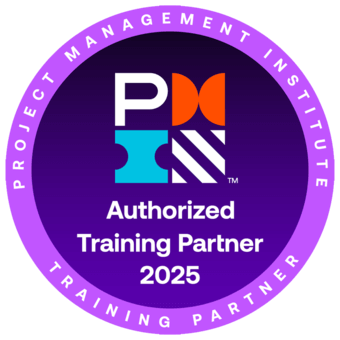Project Performance and Delivery
Project Performance and Delivery
Skills you’ll gain
Performing work that delivers the right results is the primary goal of any project. In this Project Management Performance and Delivery course, you’ll learn how to drive optimal project performance and successfully deliver your projects using today’s best practices and methods in traditional and Agile Scrum project management.
You’ll learn all the necessary elements to execute a successful project, including how to ensure team compliance, track critical metrics, navigate everyday challenges, and close out your project.
By the end of this Project Management Performance and Delivery course, you’ll be able to:
- Assign and allocate tasks.
- Measure performance metrics, from earned value and variance analysis to forecasting results.
- Verify performance improvement.
- Handle unforeseen project roadblocks, including scope creep, change management, and timeline constraints.
- Demonstrate deliverables to stakeholders.
- Facilitate a smooth project transition after executing changes, assessing outcomes, and delivering final reports.
- Learn the tools to deliver and close your project with 32 engaging lessons, including real-world examples and actionable exercises.
- Earn 16 PDUs or contact hours toward your Project Management education for certification with PMI.
This course is based on The Project Management Institute,
If your goal is to become a Certified Project Management Professional, then we recommend taking our additional courses on Project Management Framework, Project Teams and Stakeholders, and Project Planning.
Once enrolled, our friendly support team and tutors are here to help with any course-related inquiries.
Syllabus
Download syllabus-
1
Project Team Dysfunctions Since project teams are comprised of people, there are times when the project team will become dysfunctional. Team members begin to violate team ground rules and team cohesion and trust are undermined. In this lesson, we discuss a framework for recognizing this and addressing dysfunctional behavior. 5m
-
2
Measuring Compliance Attributes of governance and compliance were discussed in planning. However, it is during project execution that compliance is demonstrated. In this lesson, we discuss the techniques to be used to monitor the level of compliance on a project. 5m
-
3
Achieving Compliance Depending upon your organization's culture, compliance may be a primary value or it may only be treated as a minor element of project management. In this lesson, we discuss the compliance mindset and multiple methods for strengthening compliance on your project. 4m
-
4
Survey Business Environment There are a growing number of things outside the control of the project team in today's business environment. The project manager must monitor the industry and organization to assess the impacts. Risk management has expanded to include items outside the control of the project team. 5m
-
5
Confirm Project Compliance Project compliance with all appropriate standards, regulations, policies, and requirements documents is the responsibility of the project team. However, typically an independent review of compliance, in the form of a project audit, is done to confirm compliance. 5m
-
1
Project Dashboards Learn how to create and use a project dashboard to communicate project status with both management and your project team. 4m
-
2
Earned Value Planning Earned Value Management is a comprehensive project management technique that combines scope, schedule and resource management into one set of measures. It starts with task-level planning. 6m
-
3
Setting Earned Value Earned Value Management is a comprehensive project management technique that combines scope, schedule, and resource management into one set of measures. An element, in fact, the element that provides the name of the technique, is the setting of Earned Value. 6m
-
4
Variance Analysis Variance occurs when the actual situation is different from the planned or expected situation. In projects, variance analysis applies to schedule variance and cost variance. It determines both why the actual situation is different than what was planned and the impact that will have on the project. 6m
-
5
Forecasting Project Results Since projects seldom go exactly as planned, part way through a project the project team is typically asked to estimate how much time and money are required to complete the project. 7m
-
1
Issue Resolution Issues are any request, complaint, or unexpected condition that leads to unplanned, but in scope, work that must be accomplished on a project. They normally result in the need to implement a workaround in order to resolve them. 4m
-
2
Roadblocks Roadblocks are impediments that prevent the Scrum Team from completing Stories and tasks. The Scrum Master is charged with removing or creating a workaround for the Roadblocks. 6m
-
3
Contingency and Triggers Contingencies are potential risk response actions that will only be implemented if some triggering event or condition has shown that the risk probability has gone from unlikely to likely. 4m
-
4
Scope Creep Scope creep is the uncontrolled expansion to project scope without adjustments to time, cost, and resources. 5m
-
5
Project Acceleration There are several approaches a project team can take to accelerate project tasks. Each approach has its own unique characteristics and risks. 7m
-
6
Baseline Management The project performance is tracked against an integrated set of project baselines that support the achievement of the project’s triple constraint goals and objectives. 5m
-
7
Change Planning The unique nature of projects leads to an inherent level of uncertainty. Project managers should expect and plan for project change. 5m
-
8
Project Change A formal documented modification to the project baseline, boundaries, or an artifact. 6m
-
1
Lessons Learned Lessons Learned are a retrospective look at a project, or phase of a project, to identify best practices to be repeated and performance gaps to be improved. 4m
-
2
Retrospective The Sprint Retrospective is a lessons learned meeting with a focus on identifying opportunities to improve the performance and management of the next Sprint. 4m
-
3
Refinement The Backlog Refinement is the update of the Product Backlog based upon what has been completed and what has been learned in a recently completed Sprint. 3m
-
4
Transition to Business To fully realize the benefit of a project, often business systems need to change to implement the project results. This transition can be a challenging aspect of the project. 5m
-
5
Final Report In many organizations, a final report is prepared after all project activities have been completed and the impact of the project results have been demonstrated in business performance metrics. 4m
-
6
Administrative Closeout In addition to transitioning the result of the project into the organization’s operations, projects often have accounts, systems, and resources that must be closed or disposed of before the project is fully closed. 6m
Certificate
Certificate of Completion
Awarded upon successful completion of the course.

Instructor
Ray Sheen
Ray is a certified Project Management Professional (PMP) with the Project Management Institute, a certified Scrum Master with Scrum Alliance, and certified Lean Six Sigma Black Belt with IASSC. He is a member of the Project Management Institute and the Product Development Management Association.
He is president and founder of Product & Process Innovation, Inc. and is a veteran business leader with over 25 years of executive, project management, and engineering management experience. Ray has worked in several industries including aerospace, electrical distribution and utilities, biotechnology, appliances, electronics, machining, medical devices, pharmaceutical, automotive, and financial services. He has held executive management positions in a Fortune 500 company and has been involved in entrepreneurial startup organizations.

Ray Sheen
Project Management Instructor & Author
Accreditations
Link to awards The PMI ATP seal, PMI, PMP, CAPM and PMBOK are registered marks of the Project Management Institute, Inc.How GoSkills helped Chris
I got the promotion largely because of the skills I could develop, thanks to the GoSkills courses I took. I set aside at least 30 minutes daily to invest in myself and my professional growth. Seeing how much this has helped me become a more efficient employee is a big motivation.



